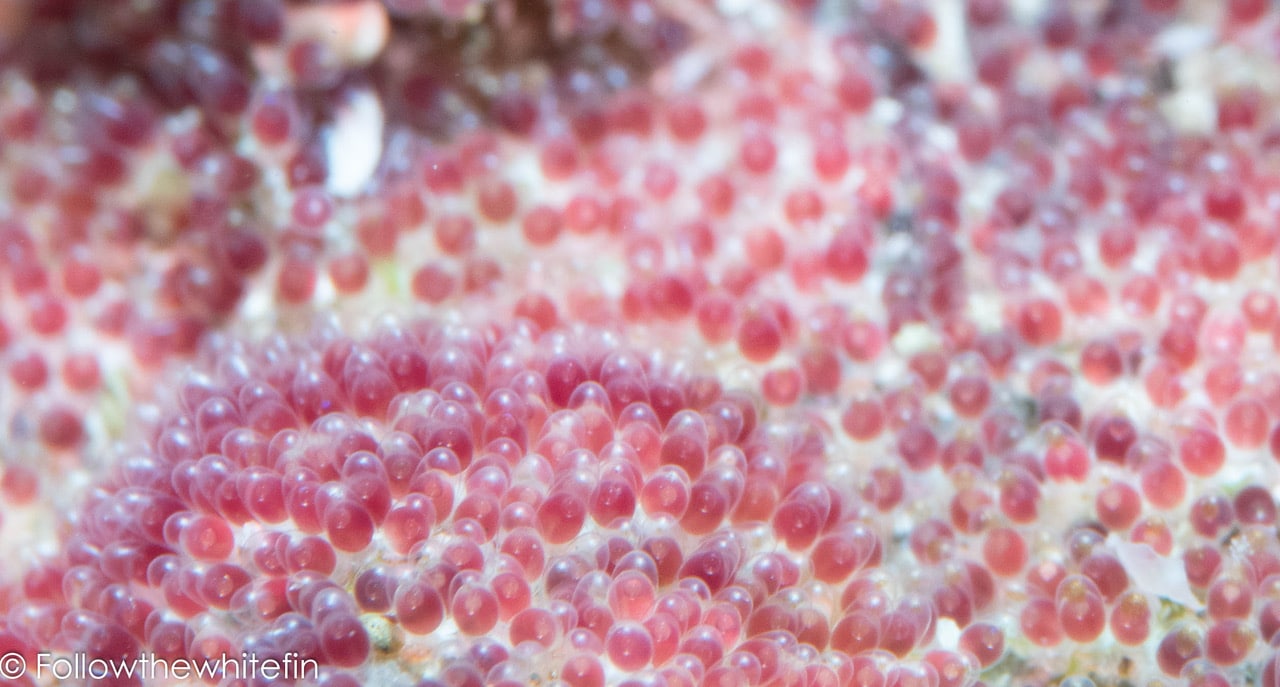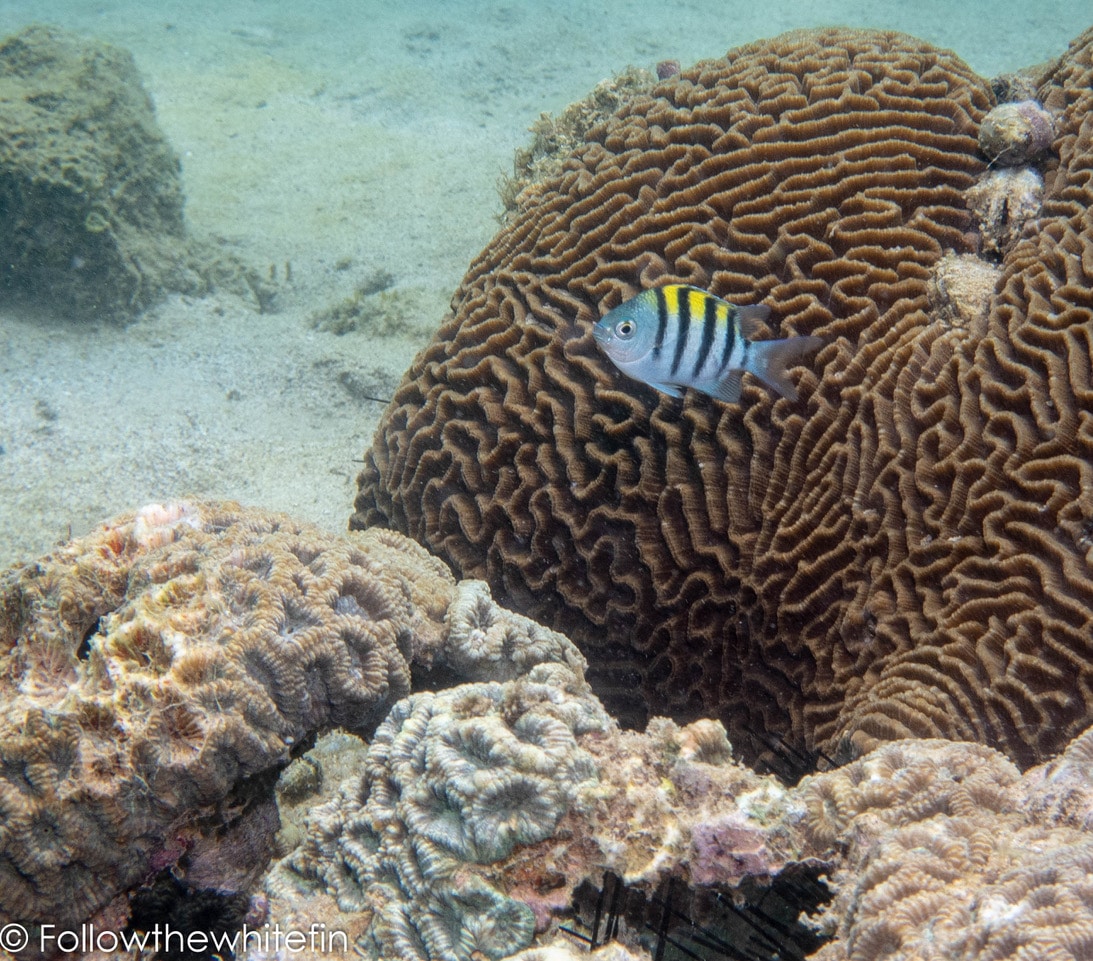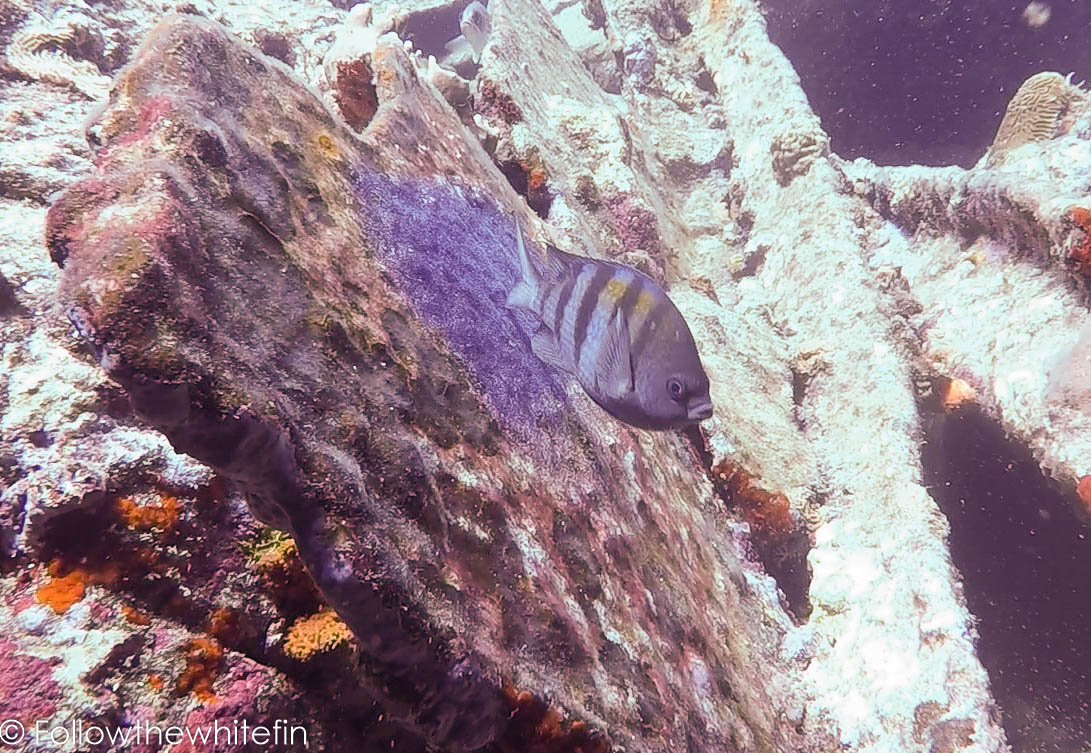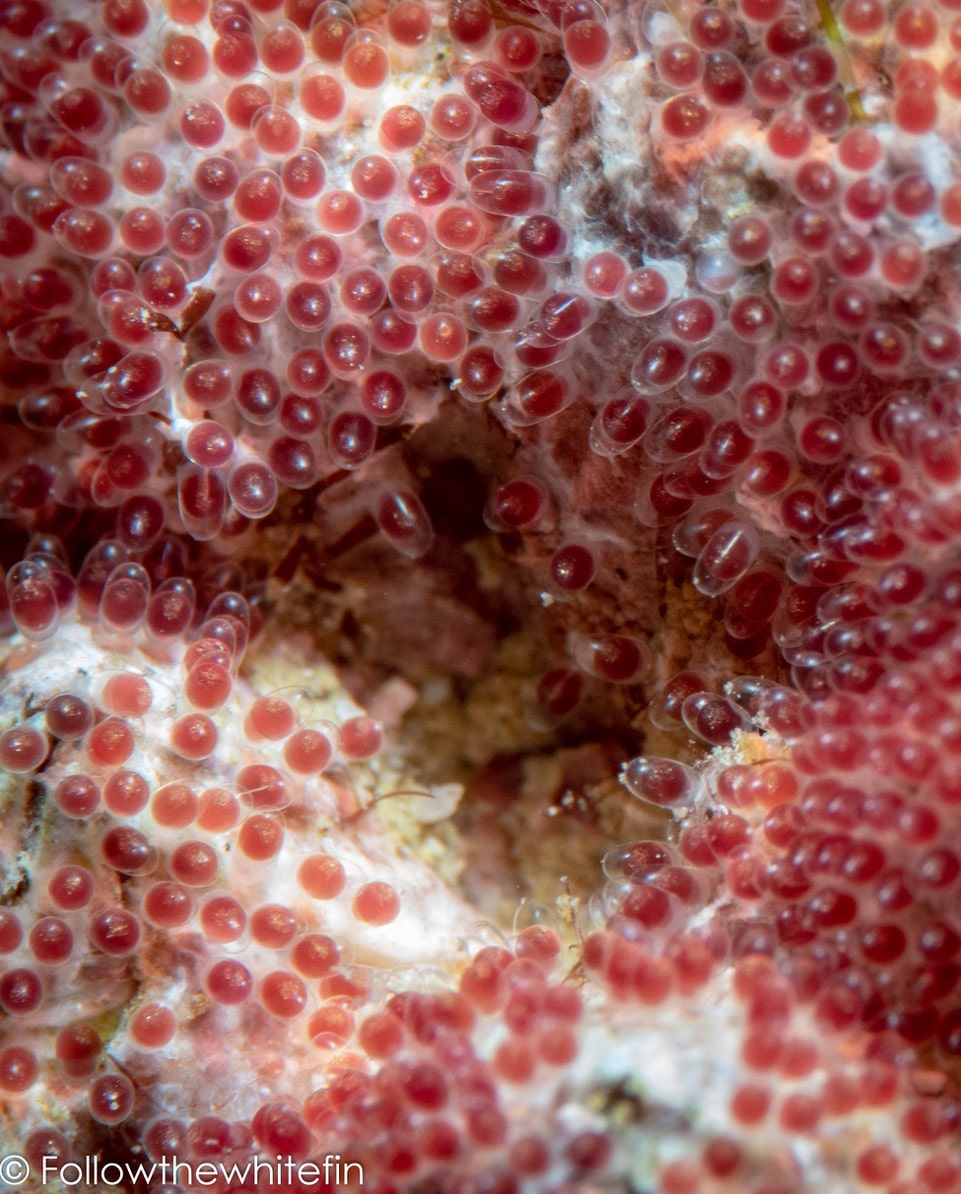Marine Life & Conservation
The Sergeant Major Fish: Underdog to Super-Dad

You’re on a dive, minding your own business when suddenly, your mask is being bombarded by a frantic and extremely angry creature. In shock you reverse, exiting the firing line when you realise that the monster in question is none other than the Sergeant Major Fish.
If your biggest fear in the ocean is the ‘dreaded shark’, think again, it’s the Sergeant Major you really have to worry about!! In disbelief you take a second glance and notice that the creatures you once thought were small and peaceful are all behaving in this manner to anything crossing or invading their path.
Why do they behave like this? And why have you never noticed this before?
Background Check
Abudefduf is from the Arabic; abu “the one with”, def “side”, and duf “prominent”. Its name, referring to the vertical black bars on its side, roughly translating to “the one with prominent sides”. This is also where its gets its common name “Sergeant Major,” as the stripes resemble the bars on a military uniform. Despite the general common name Sergeant Major there are up to 20 species of this damselfish, part of the family Pomacentridae, that you can be found worldwide. Generally, their bodies are deep, oval and compressed with a continuous dorsal fin and a forked caudal fin, but each species varies in size and the number of dorsal fins, dorsal soft rays, anal spines and anal soft rays.
Meet the Locals
Here in the UAE we have the Indo-pacific Sergeant Abudefduf vaigiensis. Widely distributed throughout the Indo-Pacific: Red Sea, Indian Ocean to eastern Africa, north to southern Japan, and south to Australia. In 1991, it was even discovered in the Hawaiian Islands, possibly floating marine debris such as abandoned fishing nets, where it now coexists with the Hawaiian Sergeant Abudefduf abdominalis. They form large aggregations while feeding during the day and play hide and seek by themselves at night on coral reefs, tidal pools and rocky reefs at depths between 1 to 15 m. The Indo-pacific Sergeant can grow up to 20 centimetres long, feeding on zooplankton, benthic algae and small invertebrates.
The Interesting Part!
So now you have the Sergeant Major’s background check. Here’s the fascinating part!
Between March and August, the Sergeant Majors congregate in large numbers to reproduce. To start the process, the males prepare temporary nesting sites by coating patches of rocks, shipwrecks and corals with an adhesive substrate. The females then wander around looking for that special partner to mate with. When a female is near, the male will try to attract the female by preforming a unique and intriguing dance which involves moving up and down erratically, like the local dance club. If she’s digging his moves she will deposit up to 20,000 eggs. Once the eggs have dispersed, they attach themselves to the substrate the males prepared and will then be fertilized.
After all the fun, the females eventually take off leaving the males with all the responsibility of protecting his little patch. The male is extremely attentive by continuously aerating his eggs stopping fungus build up. He will also turn a darker bluish colour which most likely acts as a warning colour to predators or even possible camouflage. Any fish that comes too close are aggressively chased away and divers are left in bewilderment.
The eggs start as solid red ovals around 0.5-0.9mm. Once they are fertilised they start to turn a green colour with a deep red yolk leaving the surfaces as a patchwork. After 4-5 days the eggs will hatch an hour after sunset. If you are able to see the hatching, it can be amazing to watching as they wiggle out from the substrate and break free. Once hatched they are around 2.4mm in size and set off to tackle the big blue ocean.
I have been very privileged over the last few weeks to witness parts of this process and they are amazing to watch. The reef has literally been covered in patches of varying shades of red and green. The determination of the male Sergeant Major whilst hilarious to watch is also impressing for such a small creature to display. With my new camera I was able to catch some of these processes, but my next goal is to capture the courtship ritual and hatching (I may need a bigger camera though).
Next time you are out diving, make sure you don’t overlook the little guys, and look out for the patchwork of the ocean created by the Sergeant Major Fish.
Find out more about Kayleigh at www.followthewhitefin.com
Marine Life & Conservation
Shark Trust launches Oceanic 31 Shark Art Auction

 After a two-year tour of UK art galleries, community spaces and aquariums, the Shark Trust’s acclaimed Oceanic31 exhibition takes its final bow at the Royal Geographical Society later this month. And the unique collection of artwork, depicting 31 species of oceanic sharks and rays, donated by 31 artists, is now open for bids from art lovers and shark enthusiasts. The online auction, launched today, will close on the 7th December at 8pm (BST). The money raised will support the Shark Trust Oceanics Programme.
After a two-year tour of UK art galleries, community spaces and aquariums, the Shark Trust’s acclaimed Oceanic31 exhibition takes its final bow at the Royal Geographical Society later this month. And the unique collection of artwork, depicting 31 species of oceanic sharks and rays, donated by 31 artists, is now open for bids from art lovers and shark enthusiasts. The online auction, launched today, will close on the 7th December at 8pm (BST). The money raised will support the Shark Trust Oceanics Programme.
People can now bid on 27 of the artworks by visiting this website:
https://superstars-auctions.com/sharktrustauction
It is a chance to own a beautiful piece of original art and to support the Shark Trust. The timing of the auction also means that these would make a very special Christmas gift for any shark-lover.
- Bigeye Thresher Shark by Janina Rossiter
- Carcharodon carcharias by Jimmy Higgs
- Croc VR 2030 by Tom Mead
- Oceanic Whitetip by ATM
- Silky Street by ScapaJoe
The diversity of pieces mirrors that of the sharks and rays they represent. You can bid on paintings, digital creations, sculptures, mixed media and more. You can pick your favourite artist or species of shark. Or you can select the perfect artwork to make a statement in your home or office. Whichever you choose, you will be supporting the work to protect these amazing animals.
One of the pieces of art has been selected to be auctioned live by Steve Backshall at the For the Love of Sharks event at the Royal Geographical Society in London on the 29th November. In addition to this, two further pieces will be raffled at this event, giving people a chance to win an incredible piece of shark art. For the Love of Sharks is the Shark Trust’s flagship evening. A night to celebrate sharks. Steve Backshall is the headline speaker at this event that will see other prominent shark advocates join him on stage.
Tickets for the event can be snapped up here:
https://thesharktrust.org.uk/Event/flos24
Those that would like to see the Oceanic 31 exhibition have one final chance. It is being displayed at the Pavilion at the Royal Geographic Society from 26th November until the 7th December. Entry is free.
Find out more here:
https://www.rgs.org/events/upcoming-events/oceanic-31
Paul Cox, Shark Trust CEO, Said “This exhibition has given us the opportunity to reach out to a new audience. And inspire more people with the wonderful sharks and rays on which our Big Shark Pledge campaign is based. We are immensely grateful to the 31 artists who have worked so hard to create these works.”
Bid for your favourite Oceanic 31 artwork here:
https://superstars-auctions.com/sharktrustauction
Banner Image: Smooth Hammerhead by Alicia Hayden
Marine Life & Conservation
Meet Steve Backshall in the Bite-Back Prize Draw

Until 28 November, prizes worth a massive £10,000 – including experiences, products and tuition – feature in a line-up of items that can be won for £5 in an online prize draw to celebrate Bite-Back Shark & Marine Conservation’s 20th anniversary and help generate crucial funds for the future.
Top of the list of prizes is the chance to spend time with adventurer and wildlife expert Steve Backshall, a workout session with Nat Geo star Aldo Kane, a kayaking trip alongside white-water expert and diver Sal Montgomery and a Zoom call with ‘shark whisperer’ Cristina Zenato.
On top of that, some of the most admired companies in the diving and scuba industry have been quick to support the charity with fabulous prizes that make the £5 ticket price worth more than just a flutter.
Master Liveaboards, BSAC, Midlands Diving Chamber, Go Freediving and Blue Shark Snorkel have all generously donated experience prizes, while celebrated photographer Alex Mustard has donated a print and artists Scott Gleed and Olivier Leger have donated a sculpture and illustration to help boost the fundraising pot.
Fourth Element has donated Ocean Positive gear and LA watch company Nodus has gifted the charity a stunning dive watch. For land lovers, the charity has included a five star London hotel stay at Bankside Hotel plus a family visit to Longleat Safari Park in the roster of prizes.
Campaign director for Bite-Back, Graham Buckingham, said: “We’ve been overwhelmed with support from companies and individuals that we truly admire and who have supported us on our 20 year journey and we’re truly grateful to them all. While we feel incredibly proud of our achievements over the past two decades – and we are super excited about the next chapter – this prize draw isn’t a vanity project. It represents a real lifeline to our work and important advancements in the global protection of sharks. So we hope divers, dive clubs and even bargain hunters grab some tickets to make this a massive success.”
The charity hopes that the prize draw will generate crucial funds to launch a brand new, ground-breaking, campaign to enrol the public and increase support for the protection of sharks around the world.
To enter the competition visit www.bite-back.com/prizedraw. The prize winners will be announced on 1 December 2024.
-

 News1 month ago
News1 month agoIconic SS United States to become the World’s Largest Artificial Reef
-

 Blogs3 months ago
Blogs3 months agoNovoScuba’s Game-Changing Approach for Dive Store Owners: WE PAY YOU!
-

 News2 months ago
News2 months agoBook Review – 52 Assignments: Underwater Photography
-

 Gear News2 months ago
Gear News2 months agoDYNAMICNORD – New German diving brand enters the British market
-

 News2 months ago
News2 months agoExploring Cenote El Pit: A Diver’s Dream
-

 Gear News2 months ago
Gear News2 months agoTry BARE drysuits (and maybe even win one!) this Friday with Sea & Sea at North West Dive Fest
-

 News3 months ago
News3 months agoComing Soon – 52 Assignments
-

 News3 months ago
News3 months agoSave £200 per person per week at Pole Pole Lodge with Dive Worldwide











